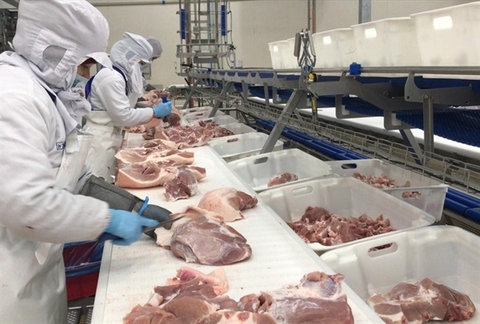
From April 1, the live hog price will drop to VND70,000 per kilo from the current VND75,000. — Photo tienphong.vn
Deputy Prime Minister Trinh Dinh Dung and Minister of Agriculture and Rural Development Nguyen Xuan Cuong on Monday in Ha Noi called for 15 major livestock enterprises to reduce the price of live hog to VND60,000 per kilo for stability in the domestic market during the COVID-19 pandemic.
From April 1, the live hog price needs to drop to VND70,000 per kilo from VND75,000. It would continue reducing to VND65,000 per kilo by the end of the second quarter and VND60,000 in the third quarter, Dung said.
To achieve this goal, besides the efforts from the Ministry of Agriculture and Rural Development (MARD), localities and businesses, the Deputy PM said the Ministry of Industry and Trade (MoIT) and the Ministry of Foreign Affairs need to support Vietnamese businesses in finding more pork supplies from other countries because the COVID-19 pandemic has affected trade activities.
Meanwhile, the MARD and MoIT would also organise pork imports according to the Prime Minister’s directions.
The Ministry of Finance should consider reducing import tax on pork, Dung said, while the MoIT must manage pork supply chains in the domestic market to avoid speculation and price inflation, especially in intermediate stages.
In addition, provinces and cities should create favourable conditions for farmers and businesses to re-produce pigs, he said.
The localities, especially in the North, need to prevent and strictly handle cases of smuggling pigs and pork products from Viet Nam to other countries.
At the meeting, representatives of the large livestock enterprises such as CP Viet Nam Company, Mavin Group, CJ Vina Company, Dabaco, Japfa Comfeed and Emivest, pledged to cut the price of live hogs to VND70,000 per kilo from April 1.
According to Minister Cuong, the structure of meat consumption has changed but pork will still be an important food, accounting for 65-70 per cent of meat consumption demand in Viet Nam.
From the beginning of March this year, the live hog price decreased. However, it is still at a high level now, Cuong said. The price needs to go down to a reasonable level for curbing inflation of the economy and also harmonising the interests of farmers and consumers.
That would maintain sustainable development of the domestic pork market, he said.
At the meeting, Vu Anh Tuan, deputy general director of CP Vietnam Livestock Joint Stock Company, said CP Viet Nam has cut the price of live hogs to VND73,000-75,000 per kilo now from VND80,000-85,000 early this year.
Other large livestock enterprises have lowered their prices for live hogs but consumers must still buy pork at very high prices, Tuan said.
“With the price of live hogs at VND75,000 per kilo, the selling price of pork is only around VND100,000 per kilo. In fact, the average price of pork on the domestic market is still at a higher level and even up to VND140,000,” Tuan said.
That means the cost for intermediary stages currently accounts for a large part of the selling price, so the State needs to have solutions to reduce this factor.
In the future, CP Viet Nam will promote the sale of pork to consumers, he said. The company expects to put its slaughterhouse in Chuong My, Ha Noi into operation by the end of 2020, with a capacity of over 4,000 pigs per day. This will complete the company’s supply chain and reduce the intermediaries. Besides, CP Viet Nam has cooperated with processing plants to produce chilled meat products for domestic consumption.
Meanwhile, the companies at the meeting said that the Government should put pork on the list of price stabilisation goods to avoid strong fluctuations in price.
According to MARD, to reduce the pork price, the Government has permitted to increase pork imports from the end of 2019.
From January 1 until March 27, Viet Nam imported 39,191 tonnes of pork, a year on year increase of 312 per cent, including 25.8 per cent from Canada, 20.6 per cent from Germany, 13.8 per cent from Poland, 9.7 per cent from Brazil, 7.7 per cent from the US and 2.6 per cent from Russia.
The ministry also expects that the domestic production will supply a total output of 3.9 million tonnes this year to meet domestic consumption. Of which, there are 811,000 tonnes in the first quarter and 950,000 tonnes in the second quarter. The output is estimated to surge to 1 million tonnes in the third quarter and 1.1 million tonnes in the fourth quarter. — VNS